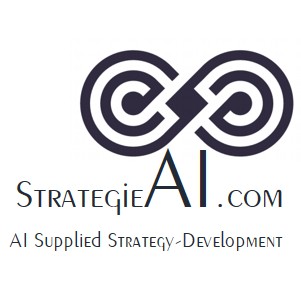We must not constrict the universe in order to adapt it to the limits of our imagination, as humans have tended to do in the past. Rather, we must expand our knowledge so that it is able to grasp the image of the universe.
Francis Bacon, English philosopher
StrategieAI.com informs you about the key issues affecting the future viability of companies.
Recently, a student who is about to take his Master's exam shared an interesting observation with me: His father handed him the 1980s bestseller "In Search of Excellence" by Peters & Waterman from his library, which he read with great interest. But his question was justified: Why are most of the benchmark companies from this book no longer in existence today? What has happened? I expanded this question to include the perspective of why many once excellent companies, pioneers and market leaders, often fail so abruptly. The list is long, from Atari to Wang, and in more recent years includes names such as Kodak, Polaroid, Enron, Nokia, Toys "R" Us or Blockbuster, right up to the current WeWork or Signa.
In most cases, the reason is that these companies failed to reach the next corporate life cycle with viable business models and services. They missed the innovative boat because they ignored fundamental developments and made the wrong management decisions, often accompanied by the arrogance of past success.
How companies understand the world is how they lead. A common shortcoming on the way to making the wrong decisions is sticking to industry or product markets instead of focusing on the "Original Customer Need" (OC) and the resulting "Strategically Relevant Market" (SRM).
This is not just about superficial products or services, but about the deeper intention and motivation behind the demand decision. Those who recognize these and get closer to them than their competitors are ahead of the game. For some providers, the risk is not so much the competitor of a comparable solution, but rather a provider who is often perceived as coming from a different industry and is taking an unfamiliar path closer to the OK. Not always, but in many cases, the OK is far removed from the superficial function or the benefit of the first appearance. This is where the zone of fundamental innovation lies.
- Most people who buy a lawn mower, for example, do not buy it because it is such an exciting product, but because it is a necessary, usually unavoidable evil for a trimmed lawn. The actual purchase intention is not the mower, but the desire to have a well-tended garden in which to enjoy their leisure time. If a supplier came along who offered gardening enthusiasts a genetically treated grass seed that could withstand frequent droughts as well as remaining standing at 2 cm after sowing, many would certainly no longer buy a mower because the problem could be solved in a much more effective way.
Every company must therefore be aware of the OKs served in order to see the risks from completely different sectors and to create innovations from new perspectives. The central task is therefore: What is my "job to do" in order to satisfy this original intention of the customer better than anyone else? It may well be that the driving force behind the purchase is to be found in the customer's not yet conscious and communicable latency area, i.e. an innovator understands what the customer is actually looking for better than the customer himself. This also explains why traditional market research does not provide any insights for real innovations or disruptions. Nobody would have defined a "smartphone" as a purchase briefing for Steve Jobs.
Complexity offers creative opportunities on the way to offers that are closer to the core need. This requires a closer look at the system in which a solution is positioned, not the direct product-competitive environment. After all, following others who may still be riding horses in markets that are already dying is not the path to success. Complexity is not complexity. Rather, it is found in every system whose parameters are not in linear and logical, extrapolable relationships, but rather act in a surprising, unplannable and dynamic to chaotic manner. A system is a totality of elements that are related to each other and generate and form interactions in such a special way that they function and can be understood as a task-, meaning- or purpose-bound unit. If the - often surprisingly few - driving parameters of a system are recognized, they can be influenced by new synapses of thought in order to develop innovations that were previously hardly conceivable.
Every company must therefore recognize the OKs served in order to identify risks from other industries and create innovations from new perspectives. The central question is: What is my "job to do" in order to fulfill this original intention of the customer better than anyone else?
Complexity offers creative opportunities on the way to offerings that are closer to the core need. By identifying and controlling the driving parameters of a system, innovations can be developed that were previously inconceivable.
AI can play a crucial role in measuring and recognizing innovative networking options. The reality of a system comprises many shades of gray that cannot simply be converted into mathematical key figures. However, fuzzy logic and new tools for complexity analysis can be used to make well-founded statements and create digital simulations.
Business models and strategies for the future are increasingly being sought in markets that are no longer defined by products, sectors or technologies. They must be developed via relevant system environments and original customer intentions.
The development of such business models and strategies requires a different culture of thinking and leadership within the company. Linear logic and extrapolation of yesterday into tomorrow are unsuitable. Strategy must be flexible and iterative in order to do justice to dynamic changes.
Strategic corporate management requires two core competencies:
- A fundamental orientation towards the control factors of the relevant system.
- The ability to understand and adapt strategy as an ongoing and iterative task.
The most important core competence for complexity-capable leadership is intuition. The more complex organizations become, the more important it is to use and integrate intuition into daily processes and decisions.
The more complex organizations become and the faster changes occur, the more important intuitive assessment strategies become. Intuition is a mixture of creative and mostly unconscious abilities, knowledge and an adaptive toolbox of instincts. It enables quick judgments, decisions and feelings, the origin of which is often unknown, but nevertheless strong enough to motivate action. Intuition is like an inner autopilot that knows what to do depending on the situation and unconsciously applies knowledge from experience and action. Intuition could also be described as "acting without thinking". The strength of intuition lies in its unconscious experiential knowledge. By continuously dealing with complex problems or topics, we gather conscious and even more unconscious knowledge that further develops our intuition.
Gut feelings or intuition are often based on little information and arise spontaneously. Intuition can ignore and filter information and recognize as correct what it considers relevant. Our brain has the ability to protect us from information overload by automatically sorting out information without our conscious intervention.
- Gerd Gigerenzer made an interesting discovery in an experiment with football players: he investigated how players with a high success rate catch high balls. These players ran unerringly in the direction of the ball every time it flew and hit it exactly at the point where its trajectory reached them. What exactly was happening? The coach thought that the good players would think about where the ball might land and then run there to meet it. So he asked the players to start running even earlier so that they would have more time to make corrections at their destination. However, the catch rate dropped and often the players were not even at the right spot. The experiments showed that good players did not think at all about where the ball might land. They simply fixed their gaze on the ball as soon as it was kicked and intuitively adjusted their running speed and direction to the trajectory of the ball. The intuitive rule of thumb was simple: keep the angle of vision to the ball constant. The player could not rationally calculate the landing point, but thanks to the intuition of an inner, repeatedly trained experience program, he found it automatically.
Above all, this example also shows how important it is to allow and use intuition in the management of companies and people and to incorporate it into daily processes and decisions.

